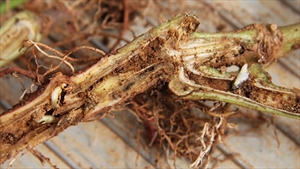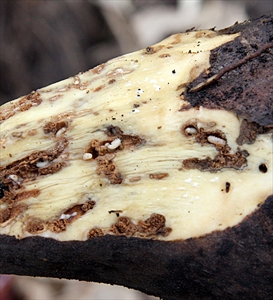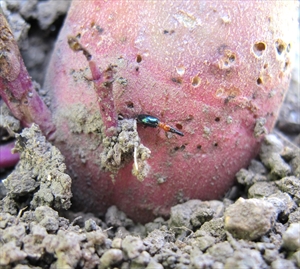Sweetpotato weevil
Pacific Pests, Pathogens, Weeds & Pesticides - Online edition
Pacific Pests, Pathogens, Weeds & Pesticides
Sweetpotato weevil (029)
Cylas formicarius
Asia, Africa, North, South and Central America, the Caribbean, Europe (intercepted only), Oceania. It is recorded from Australia, American Samoa, Cook Islands, Federated States of Micronesia, Fiji, French Polynesia, Guam, Kiribati, Marshall Islands, New Caledonia, New Zealand, Niue, Northern Mariana Islands, Palau, Papua New Guinea, Samoa, Solomon Islands, Tonga, Tuvalu, Vanuatu, and Wallis & Futuna.
Sweetpotato (Ipomoea batatas), and many types of morning glory.
Damage is done by the adult beetles and grubs or larvae. The adults feed on the buds, leaves, vines and storage roots. However, grubs cause most damage by tunnelling through the stems (Photos 1-3) and storage roots (Photo 4). In the storage roots, tunnelling produces chemicals called terpenes, which give the flesh an unpleasant taste.
Female beetles lay eggs singly in the base of the vines, or crawl through cracks in the soil to lay eggs in the storage roots. The eggs are white, oval, and about 0.5 mm long. They are sealed in with a protective grey faecal plug. Several hundred eggs are laid over a lifespan of about 4 months.
The grubs are legless, white, with a brown head and reddish-brown gut. At maturity, the grubs are up to 8 mm long; they then pupate. Pupae are creamy white, up to 6 mm long. This stage lasts about a week. After coming out of the pupa, the adult beetle stays in the tunnel for about a day before cutting through to the outside.
Adult weevils are small and ant-like (Photos 4&5). They are 5-7 mm long, with a smooth and slender body and snout. Their head and rear are metallic blue or black, and their middle, legs and antennae are red. The full lifecycle takes just over a month. The adult weevils feed on the leaves, vines and storage roots, but do little damage. On the storage roots they make small shallow pits as they feed (Photo 7).
Sweetpotato weevil is considered to be the most serious pest of sweet potato, with reports of losses ranging from five to more than 80%. Losses increase the longer the crop remains in the ground unharvested. The impact on yield depends to a great extent on the soil and weather. Light sandy soils and low rainfall increase the chances of heavy infestations. There is also evidence that red-fleshed low dry matter varieties are more susceptible to infestation.
Look at the base of the plant for small holes and damage to the stem. Break the stem to see if there are tunnels, rots and larvae. Dig up a storage root and look for damage to the skin, and feeding tunnels of the larvae inside. Adult beetles are most active at night, but can sometimes be seen on plants during the day. A pheromone is available which attracts male weevils (Photo 8). It is useful for estimating the relative number of weevils in any location.
QUARANTINE
The unrestricted movement of plant propagating material (cuttings, shoots and storage roots) has the potential of further spreading the weevil, and should be done with caution. The FAO/IBPGR Technical Guidelines for the Safe Movement of Sweet Potato Germplasm (http://www.bioversityinternational.org/e-library/publications/detail/sweet-potato/) should be followed.
NATURAL ENEMIES
Predatory ants, beetles, spiders and earwigs attack adult weevils. Tiny wasps attack them too. They also become infected by Beauveria, a fungus. Bacteria and nematodes kill the grubs. However, none of these organisms appear to make significant reductions in the weevil populations.
BIOLOGICAL CONTROL
The fungus, Beauveria bassiana, is produced in large quantities and used intensively for the control of sweet potato weevil in Cuba. Sprays of the fungus have largely replaced the use of chemical insecticides. Also in Cuba, predatory ants (Pheidole megacephala, the big-headed ant) have been used effectively to control weevils. Research on both these potential biological control organisms is being done in Papua New Guinea.
CULTURAL CONTROL
Before planting:
- Choose short-season varieties, i.e., those that produce a crop early. Note that PT (pathogen-tested) varieties without virus infections are likely to give early and high yields.
- Avoid planting sweet potatoes in the same area 2 years in a row, and plant well away from infested crops. Grow sweet potatoes in the same field only once every 3-4 years.
- Select 'clean' cuttings (25-30 cm long) from fresh young growth to reduce the spread of weevils.
- Use varieties which set their roots deep in the soil, and/or plant vines deeply.
During growth:
- Hill-up around the plants, to cover any cracks that have appeared in the soil. Weevils usually access roots via cracks in the soil. Also, prevent cracking by spreading mulch to keep the soil moist.
- Harvest the crop as soon as it has developed sizeable roots.
After harvest:
- Destroy crop residues left in the field after harvest, as weevils survive in discarded storage roots and also in the stems of harvested vines. This is THE most important part of the management of this pest.
CHEMICAL CONTROL
These recommendations are for commercial growers; those selling their produce in markets where signs of weevil damage would affect acceptability and price.
- Treat vine cuttings with insecticides to kill weevils and prevent infestation in new plantings. This is a better use of insecticides than blanket sprays, especially if combined with proper sanitation and the other measures listed under cultural control.
- Inspect the crop regularly, at least once a week: check the base of the vines, looking for damage and holes.
- Ideally, use the male pheromone to monitor weevil populations (if available). A commercial product is added to rubber tubing and placed in a trap (Photos 6&8). (A pheromone is a chemical released by insects to bring the sexes together. In this case, the pheromone produced by the female weevil has been made artificially.)
- Spray with insecticide (e.g., bifenthrin or fipronil) if damage occurs at the crown area of the vines (i.e., the part just above ground level). Spray routinely with bifenthrin or fipronil, every 3-4 weeks. Follow the manufacturer's directions on the label.
____________________
When using a pesticide, always wear protective clothing and follow the instructions on the product label, such as dosage, timing of application, and pre-harvest interval. Recommendations will vary with the crop and system of cultivation. Expert advice on the most appropriate pesticide to use should always be sought from local agricultural authorities.
AUTHORS Helen Tsatsia & Grahame Jackson
Information from Brookes D, et al. (2019) Origins, divergence, and contrasting invasion history of the sweet potato weevil pests Cylas formicarius (Coleoptera: Brenttidae) and Euscepes batatae (Coleoptera: curculionidae) in the Asia-Pacific. Journal of Economic Entomology XX(XX): 1-9. (https://www.researchgate.net/publication/334747037_Origins_Divergence_and_Contrasting_Invasion_History_of_the_Sweet_Potato_Weevil_Pests_Cylas_formicarius_Coleoptera_Brentidae_and_Euscepes_batatae_Coleoptera_Curculionidae_in_the_Asia-Pacific); and CABI (2020) Cylas formicarius (sweet potato weevil). Invasive Species Compendium. (https://www.cabi.org/isc/datasheet/17408); and from O'Sullivan J et al. (undated) Sweetpotato DiagNotes: A diagnostic key and information tool for sweetpotato problems. (https://keys.lucidcentral.org/keys/sweetpotato/key/Sweetpotato%20Diagnotes/Media/Html/FrontPage/FrontPage.htm). Photos 1,4,5,6 & 8 Russell McCrystal, Bundaberg, Queensland.
Produced with support from the Australian Centre for International Agricultural Research under project PC/2010/090: Strengthening integrated crop management research in the Pacific Islands in support of sustainable intensification of high-value crop production, implemented by the University of Queensland and the Secretariat for the Pacific Community.











